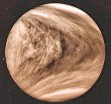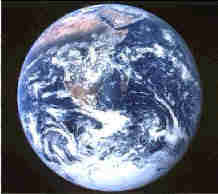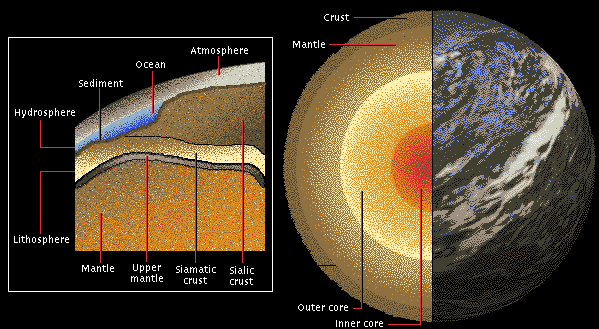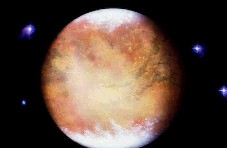
Venus is
the second nearest planet to the Sun. There, the weather is so hot that
you can bake a
cake in a few seconds! Venus can be seen with the naked (don't get excited!)
eye from Earth at night. However, it's so shiny that you might think that
it's a star. That's because its clouds reflect the sun's light. Originally,
Venus was the Roman goddess of gardens and fields, but later it was known
as the goddess of love. If you throw a ball on Mercury, it will take 2
minutes before it touches the ground.
can bake a
cake in a few seconds! Venus can be seen with the naked (don't get excited!)
eye from Earth at night. However, it's so shiny that you might think that
it's a star. That's because its clouds reflect the sun's light. Originally,
Venus was the Roman goddess of gardens and fields, but later it was known
as the goddess of love. If you throw a ball on Mercury, it will take 2
minutes before it touches the ground.
IDENTIFICATION
CARD
Name: Venus
Age: about
9 billion Earth years
Date of
Birth: 9 billion BC Birthday:
Unknown
Address: Next to its neighbour (very funny!) Go to the Sun, on the first
street, turn right. It's about 108 million km from the Sun. NOTE: This
distance varies throughout the year.
Mass: 18%
less than Earth's Radius: 95% of Earth's Mean density: 5.3 times larger
than water's
Average
Temperature: about 500 degrees Celsius (you might sweat a little bit if
you go there.) Number of Moons: (you'll never believe it)
Marital Status: I'm
very sad to tell you that Venus is not married.
Although
Mercury is nearer to the Sun, Venus is the hottest planet on Earth. Methane
clouds in Venus' atmosphere act like the "greenhouse effect". They trap
heat. It will take you 2 minutes to bake a cake on Venus!
Venus is
the brightest object after the Sun and moon. It's called the morning star
(Hesperus) when it appears in the east at sunrise, and its also called
evening star (Phosphorus or Lucifer) in the west at sunset. Ancient astronomers
believed that Venus was 2 different stars. Venus is only seen for 3 hours
after or before sunset or sunrise. Venus has phases just like the moon.
Full Venus appears to be the smallest because it is on the far side of
the Sun from the Earth's point of view. The brightest phase is the crescent
phase (a magnitude of-4.4). Venus' pattern or sequence of phases and positions
occurs once every 1.6 years.
EXPLORATION
It's very difficult to study Venus from Earth due to its clouds and atmosphere.
We know a lot about Venus because of space vehicles. The first Earth-manufactured
object to pass Venus was Mariner 2 in 1962. In 1967 and 1974, Mariner 5
+10 were launched. USSR also launched some probes. Between 1967 and 1984,
USSR sent 13 probes past Venus. However, not all of the probes reached
the planet's surface and only a few came back to Earth due to the high
temperature caused by the clouds which trap infra-red radiation. MOONS:
Venus has no moons.

THE FIRST
PLANET DISCOVERED IN THE SOLAR SYSTEM WAS EARTH! What's unique about Earth
is that it has life existing on it. Why Earth? Well, Earth has enough gravitational
pull to keep us on its surface. It's also in the perfect position for the
right amount of heat to reach it. It has water, oxygen and no poisonous
gases.

This photograph
was taken from the moon.
The Earth
is not exactly a sphere. It's flat at its poles and bulged at its Equator.
Its axis is tilted at 23.5 degrees. The highest ever recorded temperature
was 58 in Libya. There are over 190 countries. On Earth, there are four
seasons: Summer, Winter, Autumn and Spring. When it's winter in the northern
hemisphere, it's summer in the southern hemisphere; when it's spring in
the northern hemisphere, it's autumn in the southern hemisphere and vice
versa. The Earth has one moon. Actually it's called A MOON.
DAY AND
NIGHT
When one
part of the Earth faces the Sun, its day, and the other side is night.
ECLIPSES

When the
Earth comes in between the Sun and the Moon, we call that a LUNAR ECLIPSE.
The moon becomes dark and overshadowed. It's New Moon during a lunar eclipse.
Unlike the SOLAR ECLIPSE, lunar eclipse happens regularly. A lunar eclipse
may last for 11 hours.
A solar
eclipse is when the moon comes in between the Earth and the Sun. It may
block part of the Sun, PARTIAL SOLAR ECLIPSE and it may block the Sun completely,
TOTAL SOLAR ECLIPSE. Total solar eclipses are very rare and if they do
happen, they usually happen in the oceans, which cover 2/3 of the Earth.
Scientists believe that the maximum duration of a solar eclipse is 7 mins.
and 31 secs.. However, no eclipses have been recorded to have lasted that
long.
HOSHEY
BOOK OF RECORDS 2000
LARGEST
COUNTRY: Russia 1,707,5400 km (squared) 6592600m (s)
SMALLEST
COUNTRY: VATICAN CITY
LARGEST
CITY: Mount Isa, Queensland, Australia
OLDEST
SURVIVING CITY: Ariha (Jericho), Palestine 7800 BC
OLDEST
SETTLEMENT: Dolni Vestonice (Czech Republic) 27 000 BC
OLDEST
CIVILIZATION: Ancient Mesopotamian or Ancient Egyptians
BIGGEST
IN POPULATION: Cairo, Egypt 22,000,000
LARGEST
SEA: South China Sea 2,974,600 km (squared) 476000 miles (squared)
LARGEST
LAKE: Caspian Sea 3,718,00 km (squared) 143550 miles (squared)
DEEPEST
LAKE: Lake Bikal, Siberia 1637m deep
LARGEST
OCEAN: Pacific Ocean 1,612,410.00 km (squared) 45.9% of Earth
DEEPEST
OCEAN: 10924m in Pacific
SMALLEST
OCEAN: Indian Ocean
LARGEST
METEORITE: HBO West, Namibia 2.7x2.4 59 tons
EARLIEST
METEORITE: Australia, September 1969 (believed to be older than the solar
system)
FIRST CREATURES:
Procaryotic Cells
OLDEST
CREATURES: a type of bacteria which exceeds 1 billion years in age
FASTEST
CREATURES: Cheetah (110 km/h)
LARGEST
CREATURES: Blue Whale (gains 90 kg every day!)
 =
= x 101
x 101
HIGHEST
PEAK: Mount Everest 8982m above sea level
LARGEST
VOLCANO: Mona Loa, Hawaii
LONGEST
ERUPTION: Kailua Hawaii, since 1983, still erupting
WORST ERUPTION:
Karakatoa, Indonesia 1815
LONGEST
DAY: June 21st
SHORTEST
DAY: December 21st
LONGEST
NIGHT: December 21st
SHORTEST
NIGHT: June 21st
HIGHEST
RECORDED TEMPERATURE: 58 Al Azziyah, Libya
LOWEST
RECORDED TEMPERATURE: -89.6 Vostock Station, Antarctica
LAYERS
OF EARTH
The Earth
is surrounded by a huge blanket of air called the ATMOSPHERE. This atmosphere
is made out of layers. 79.3% = Nitrogen 20.6% = Oxygen 0.03% = Carbon Dioxide
0.01% = Water vapour, Argon, Radon and other gases. The atmospheric pressure
on Earth is about 100,000 Pa on sea-level, that's equivalent to 100 elephants
sitting above you!

The layer
on the troposphere which has life existing on it, is the BIOSPHERE. Under
the Earth there's another world…..
The lithosphere
or the CRUST is made up of PLATES. If plates rub against each other an
earthquake occurs. If they move apart, MAGMA from below will burst out
to form a volcanic eruption.
The Earth
has a magnetic field because of the outer core which is believed to be
made out of iron. When this core rotates, the North and South poles change
positions. Now, the poles are at an angle of 23.5 degrees.

Mars was
the Roman God of chocolates, I mean war. Scientists called this planet
Mars because it has a red colour.

If you
look at Mars with a telescope, it will have a red colour with varying brightness.
Mars is 55 million km when it's nearest to Earth. Mars is the second brightest
object in the sky. Mars is best seen when it is opposite the Sun in the
Earth's sky and when it's nearest to the Earth. This happens once every
15 years. The last time this happened was in 1971. From a telescope it
can have bright orange and darker regions. This changes throughout Mars'
seasons. Because of Mars' orbit
and tilt of its axis, it has warm southern summers and long cold southern
winters. Its red colour comes from its rusted or oxidized surface. The
dark areas are thought to be made out of basalt. Mars' polar regions are
noticeable, bright and made out of ice. In autumn, bright clouds gather
around one of the poles. During winter and autumn, carbon dioxide is deposited.
The Polar Regions are believed to be made out of frozen water. The thickness
of the ice caps might reach 2km. There are clouds made out of water, CO2
and dust.
orbit
and tilt of its axis, it has warm southern summers and long cold southern
winters. Its red colour comes from its rusted or oxidized surface. The
dark areas are thought to be made out of basalt. Mars' polar regions are
noticeable, bright and made out of ice. In autumn, bright clouds gather
around one of the poles. During winter and autumn, carbon dioxide is deposited.
The Polar Regions are believed to be made out of frozen water. The thickness
of the ice caps might reach 2km. There are clouds made out of water, CO2
and dust.
During
the first half of this century, people believed that there were aliens
who lived on Mars. H.G. Wells wrote the first story in history about aliens.
Independence Day, Alien Attack, Star Trek and all of the other films get
their ideas from Wells' War of the Worlds. In the 1970's, NASA wanted to
send a probe to Mars to see if there are aliens living there. One man,
James Lovelock said that there are no Martians there. He believed that
Mars' atmosphere had no FEEDBACK. There were no big changes. Most of it
was made out of CO2, which is a very stable gas. He was kicked out of NASA.
However,
NASA did send a probe and no aliens were found. Lovelock's theory is called
GAIA. It believes that the Earth is a living thing because there are many
changes in the atmosphere and surface, which is a characteristic of a living
thing!
MOONS:
Mars has two odd-shaped moons.

